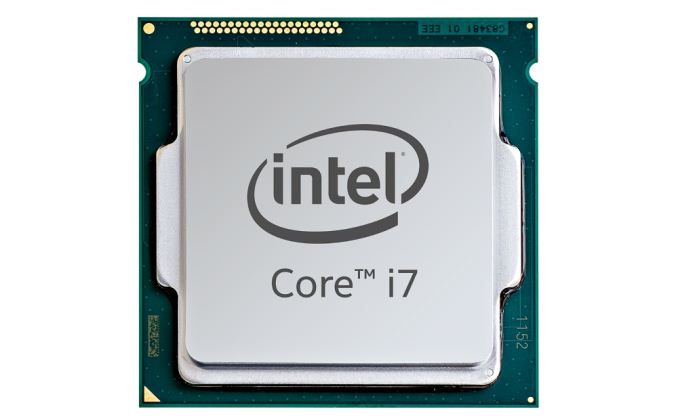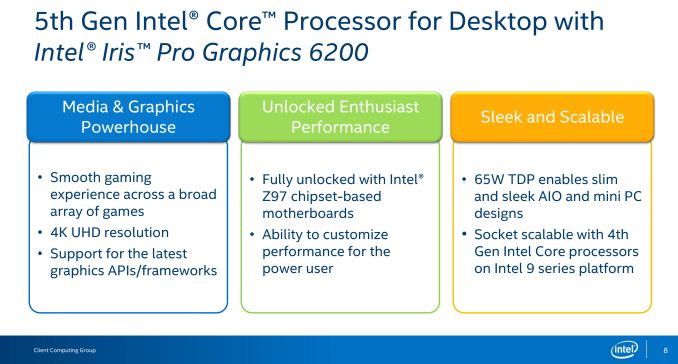The Intel Broadwell Desktop Review: Core i7-5775C and Core i5-5675C Tested (Part 1)
by Ian Cutress on June 2, 2015 7:45 AM ESTBroadwell-DT: Initial Thoughts
The new Broadwell desktop processors are somewhat out of sync with our regular expectations from Intel. Due to issues surrounding the 14nm node, as well as the cost, the whole Broadwell line from tablet to table-top has come out slower and more staggered than any Intel release in recent memory. As a result, the initial launch from Intel today is a pair of 65W desktop socketed models backed up with three 65W soldered down models whose true heritage is a chip primarily designed for large laptops and all-in-one devices.
Normally we would expect a range of desktop models from 35W up to 88W or higher, but socketed Broadwell-DT today only exhibits two units at 65W. This immediately puts a slight damper on those expecting to upgrade from Haswell’s high-end, or those wanting to go from something like a Pentium G3258 on Haswell to Broadwell’s top SKU. As a result, we have to keep our expectations in check – 65W should on paper perform nearly as well as an 88W part would, except it would be reduced by several hundred MHz. Meanwhile as these processors are also fully-unlocked and overclockable, we're left to ponder whether or not the stock frequencies actually matter in that case.
Due to the differential tangent at play, these processors also exhibit Intel’s best integrated graphics package, Iris Pro (GT3e), previously reserved only for soldered down/laptop/mini-PC orientations. This graphics package comes with largest number of execution units available from Intel, 48, alongside 128MB of eDRAM that acts almost like an L4 cache. This helps alleviate memory bandwidth pressure by providing a large(ish) pool near the CPU but with lower latency and much greater bandwidth than main memory. The eDRAM has the greatest effect in graphics, but we also saw some moderate increases in our non-3D regular benchmark suite.
The benefit of the graphics package, Iris Pro 6200, means that Broadwell-DT takes the crown as the fastest socketed graphics available. Our testing showed that the even the second-tier socketed SKU, the i5-5675C, outgunned the previous title holder, AMD’s A10-7870K. Despite having the i7-5775C in to test, due to time and firmware issues, we were unable to run the numbers on the integrated graphics but will do so in a later piece.
The key element to Broadwell-DT is not to consider it a natural successor to Haswell. It doesn't so much replace Haswell-K at this time, so much as it occupies a space Intel has left neglected since the launch of Haswell – the ultimate Intel integrated graphics solution. For users on integrated graphics, where money is no object, Intel now offers you the option to combine the regular CPU performance associated with Intel and a GPU that has the added performance benefits of on-chip, high-bandwidth eDRAM. The only question is whether that combined performance is worth the potential cost, and some would say no, pointing at a combined APU + GPU solution for equivalent or better gaming performance for the same price.
Pricing for the i5-5675C is listed as $276, slightly higher than the price of the i5-4690K which is at $236 on Amazon (reduced from $265). The i7-5775C is a bit higher at $366, also a margin higher than the i7-4790K which is $339 (reduced from $380). This makes Broadwell a tough sell right now in most circumstances unless you are absolutely limited to integrated graphics and want the best solution possible in a configurable PC. Given that Intel has also mentioned Skylake in their recent Computex keynote, it implements an abnormal situation that Intel has never been in with a new platform being talked about in the same breath. We have been told that these parts exist because users wanted them, and it has been interesting to see just how the added eDRAM changes the performance with discrete graphics in the mix.












196 Comments
View All Comments
Gothmoth - Tuesday, June 2, 2015 - link
well we can dream.i could use more cores.
i use heavy multithreaded applications and do heavy multitasking.
yet i have to live with 10% better performance per cpu generation. :(
haswell-e is the only choice when i want to upgrade.
but it runs hot and i have no use at all for internal graphics.
so why not making another CPU tailored for people like us?
i mean intel makes enough different CPUs anyway.
Gothmoth - Tuesday, June 2, 2015 - link
ah that reads wrong... i know that haswell-e has no internal graphics.what i meant was... haswell-e runs hot and for the other cpus like broadwell i have no use of the internall GPU.
DCide - Tuesday, June 2, 2015 - link
All this wishful thinking on your part tells me you probably don't have a very strong, actual NEED. Because if you did, you'd be ecstatic about the 5820K or 5960X. They run at 4GHz all day long with standard air cooling and no knowledge of overclocking (I just use ASRock's SLOWEST default overclock settings in the BIOS setup).It's almost humorous when I read these benchmarks, because they so understate the true, completely stable performance of the 5960X without doing any extra work setting it up. It's nearly twice as fast as the 4790K in practice (in fact it *is* about twice as fast when you consider how easily and quickly the 4790K throttles in a typical configuration).
I realize there are situations where generating more heat in the room matters. But if your multitasking were genuinely heavy enough to warrant the upgrade to 6 or 8 cores, you'd be foolish not to take advantage of the great solution that's available right now.
MrSpadge - Tuesday, June 2, 2015 - link
Double the cores means double the power consuption. There's no way around this, except making each core run slower.. which diminishes the benefit of having them. If Haswell-E runs too hot for you, no other chip Intel would reasonably want to produce right now would satisfy you.nikaldro - Tuesday, June 2, 2015 - link
But haswell-E is still on 22nm, not 14nm.nevcairiel - Tuesday, June 2, 2015 - link
Then wait for Broadwell-E.Azurael - Tuesday, June 2, 2015 - link
Why would you want to invest in 3 sticks of DDR4 RAM which will bring nearly no performance benefit and a massively overpriced motherboard for an extra couple of cores? It's not the cost of the Haswell-Es, or even their power consumption that bugs me - I suspect dual channel DDR3 is perfectly adequate for 6 cores alone given that it is apparently adequate for 4+GPU.Still, it makes my investment in a 2500K which has been running at 4.5GHz on stock voltage for the last 3 and a half years on the cheapest Z68 board I could buy sound rather good. I think I'd struggle to gain more than 20% in performance for the outlay of buying a new motherboard and CPU. I built a 4770K-based rig for a friend last year, it won't scrape past 4.2GHz. I'm sure IPC + HT + Faster RAM makes it faster than my rig, but certainly not in any noticeable fashion.
DCide - Tuesday, June 2, 2015 - link
Obviously it wouldn't matter to you. You didn't even bother to go with an i7.But for those to whom it does matter it's the biggest step up we've seen in a desktop CPU in a long time. The additional RAM and motherboard cost is trivial to those for whom the extra performance provides more than amusement.
Azurael - Tuesday, June 2, 2015 - link
You're correct - to me, it seems adequate for video editing and running Android builds... I'm sure in your 'elite' i7 world, things are far quicker. My issue is not with the fact that Intel offers higher spec or more expensive parts. Obviously, there would be no need for 18-core Xeons in this hypothetical world. My issue the fact that they artificially constrain the 'mid' range dual channel architecture to 4 cores and lump us with an IGP that's never going to get used taking up more die space than the extra couple of cores would just because they don't have any competition.Azurael - Tuesday, June 2, 2015 - link
And by the way, a ~84W TDP CPU is going to throttle when overclocked - especially when running AVX loads. If you haven't found the current limits in the BIOS, you probably deserve to believe your expensive 6-core running at only 4GHz is twice as fast as a properly set up 4790K :P